I’ll be straight with you: if you’re tired of swinging an axe until your arms scream or renting overpriced equipment that’s never available when you need it, the Crimson Force Log Splitter is your ticket to freedom.
This beast of a machine—especially the 27-ton and 32-ton models—turns firewood prep from a backbreaking chore into a quick, satisfying task. With its sturdy build and raw power, it’s a game-changer for homeowners like me who heat with wood or just love a good bonfire.
Trust me, you’ll wonder why you didn’t get one sooner.
My Experience With The Crimson Force Log Splitter
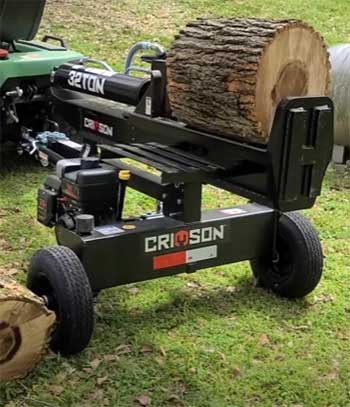
Picture this: it’s a crisp October morning, and I’m staring at a mountain of oak and maple rounds in my backyard, the kind of pile that mocks you with its sheer size.
I’d been heating my home with wood for years, and while I love the cozy glow of my wood stove, the prep was a nightmare.
My old maul and I were on bad terms—my back was practically begging for a break.
So, I took a leap and bought the Crimson Force 27-Ton Log Splitter with a Kohler 196cc engine from Rural King for $1,099.
Hands down, it’s the best investment I’ve made.
The first time I fired it up, I felt like a kid with a new toy. I was nervous—27 tons of force sounds like something out of a sci-fi movie—but the setup was simple: fill the gas, check the hydraulic fluid, and pull the starter.
It roared to life on the second pull, and I was hooked. I rolled a gnarly, knotty oak round onto the cradle, flipped the lever, and watched the 9-inch hardened steel wedge slice through it like a hot knife through butter. No struggle, no cursing, just a clean split in seconds.
I’ll never forget the grin on my face when my neighbor, Tom, wandered over, coffee in hand, and said, “Man, that thing’s a beast!” He ended up helping me split half a cord that morning, and we were done by lunch, cracking open a couple of beers to celebrate.
One moment that stands out was tackling a massive 24-inch oak round that had been taunting me for weeks. In vertical mode, I rolled it into place—no lifting, thank goodness—and the splitter powered through it without a hitch.
My wife even popped out to watch, impressed that I wasn’t drenched in sweat for once. The auto-return valve made it feel effortless, letting me focus on stacking instead of babysitting the ram. The only hiccup?
Smaller logs sometimes slipped off the cradle, which was annoying but fixable with a bit of care. By the end of the day, I’d cleared enough wood for a month, and I still had energy to play catch with my kid. That’s when I knew this splitter was a game-changer.
Tips For Getting The Most Out of Your Crimson Force Log Splitter
You’ve got your Crimson Force Log Splitter, and it’s ready to make firewood prep a breeze. But to really maximize its potential, a few tricks can take your splitting game to the next level. Here’s how I get the most out of mine, and you can too.
- Position Logs Strategically: Placement is everything. For smaller logs, center them on the wedge to avoid slipping—trust me, I learned this after a few frustrating slides. For big rounds, use vertical mode to save your back, but ensure the log’s flat end is flush against the base plate. I once tried splitting a crooked round, and it jammed the ram. Lesson learned: take a second to align the log properly, and you’ll avoid slowdowns.
- Work in Batches: Don’t just split one log at a time—set up a workflow. I stack 5-10 rounds near the splitter, split them all, then move the pieces to a pile. This keeps you in a rhythm and cuts downtime. My buddy Tom and I turned it into a competition: who could stack faster? It made a long session fly by, and we got through a cord in record time.
- Use the Right Fuel: The Kohler engine is picky about fuel. Stick to non-ethanol gas with a stabilizer to keep the carburetor happy. I made the mistake of using old gas once, and the engine sputtered like it was throwing a tantrum. Keep a dedicated gas can for your splitter, and you’ll avoid starting issues, especially in cold weather.
- Keep a Maintenance Schedule: Don’t wait for problems to crop up. I mark my calendar to check fluid levels and lubricate parts every 10 hours of use. It takes 10 minutes but saves you from mid-session breakdowns. After a big job, I give the splitter a quick wipe-down to clear wood chips, which helps me spot any loose bolts or leaks early.
Pros of The Crimson Force Log Splitter
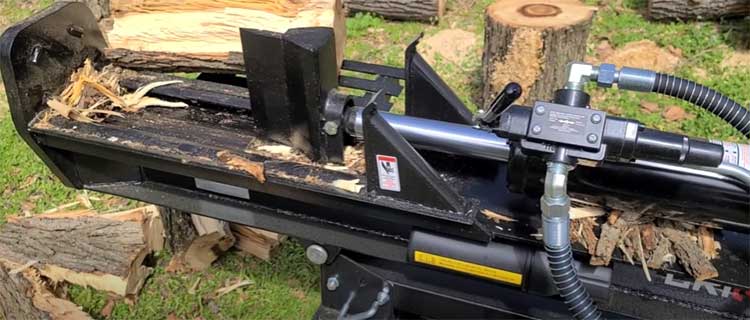
- Impressive Power for Tough Jobs
You know those stubborn, knotty logs that laugh at your maul?
The Crimson Force doesn’t flinch. With 27 or 32 tons of splitting force (depending on the model), it powers through hardwoods like oak, hickory, and elm with ease. I threw some green oak rounds at it—stuff I’d have spent hours hacking at—and it split them cleanly in one go.
The 196cc Kohler engine (or Briggs & Stratton in some models) delivers reliable power, and the 14-second cycle time keeps things moving fast. For homeowners or even small-scale pros, this power-to-price ratio is hard to beat.
- Versatile Horizontal/Vertical Design
One of my favorite features is the convertible design. You can split horizontally for smaller logs or flip it to vertical mode for those massive rounds you don’t want to lift. Switching takes under a minute, no tools required.
This flexibility saved me when I tackled a mix of sizes—12-inch maple to 24-inch oak monsters. Vertical mode is a back-saver; I just rolled the logs into place and let the splitter do the heavy lifting. It’s like having two machines in one, which is a huge plus for anyone with varied splitting needs.
- Solid Build and Easy Mobility
The Crimson Force is built like a tank. The I-beam frame feels over-engineered, with no flex even under max pressure. The 16-inch D.O.T.-approved wheels make towing a breeze—I’ve hauled it down my gravel driveway without issue.
The never-flat tires are a godsend; I don’t have to worry about punctures in the middle of a job. Plus, the handles make it easy to maneuver around the yard or into storage. For a machine this powerful, it’s surprisingly user-friendly, even if you’re not a bodybuilder.
- Enhanced Safety Features
Safety matters when you’re dealing with 27 tons of force, and Crimson Force delivers. The dual-handle operation keeps your hands clear of the wedge, and the spring-loaded lock on the frame adds stability. I never felt like I was wrestling a dangerous beast, even with tricky logs.
The stripper plates prevent jams, which is a relief when you’re splitting knotty wood that likes to stick. It’s designed with the user in mind, so you can focus on splitting without sweating the risks.
- Cost-Effective for the Power
At around $1,099 for the 27-ton model and $1,499 for the 32-ton, Crimson Force offers serious bang for your buck. Compared to renting a splitter for $90 a day, it pays for itself in a season if you’re splitting a few cords annually.
I crunched the numbers: three cords a year at rental rates would’ve cost me $500 in two years. Owning this machine is not just practical—it’s economical. Plus, the Kohler engine’s reliability means you’re not sinking money into constant repairs.
Not-So-Good Parts of the Crimson Force Log Splitter
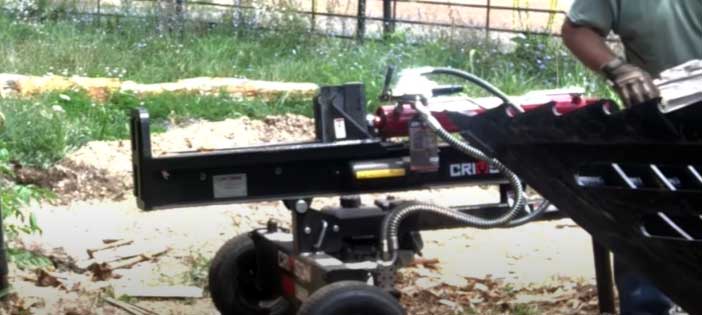
- Flimsy Log Cradle
Let’s talk about the log cradle—it’s functional but not perfect. The shelves are a bit thin and wobbly, especially with smaller logs that tend to slip off. I’ve had to reposition logs more than once, which slows you down.
Compared to higher-end models like the Iron and Oak, which have beefier cradles, this feels like a corner they cut to keep costs low. I’m planning to weld on some custom supports to fix this, but it’s a minor annoyance for now.
- Occasional Hydraulic Hiccups
I’ve heard some owners mention hydraulic issues, like air getting into the system, causing the ram to lose power or make a sucking noise on return. This happened to me once after a long session, but topping off the hydraulic fluid and tightening fittings fixed it.
It’s not a dealbreaker, but it’s a reminder to stay on top of maintenance. If you’re not handy with basic mechanics, this could be a hassle, though it’s rare with proper care.
- Engine Placement Could Be Better
The engine’s position on the splitter is a bit awkward. It’s close to the splitting area, so you have to be careful not to drop logs on it. I’ve bumped the air filter cover a few times, and it’s loose enough that I had to secure it with a zip tie.
Higher-end models, like the Timberwolf, place the engine more out of the way. It’s not a huge issue, but it’s something to watch when you’re moving fast.
- Limited Warranty Information
Finding clear warranty details was like chasing a ghost. From what I gathered, Crimson Force offers a one-year limited warranty, but it’s not well-documented at retail points like Rural King.
Compared to brands like Champion, which explicitly outline two-year warranties, this lack of transparency is frustrating. If you’re buying, double-check with the retailer to avoid surprises if something goes wrong.
Maintenance Tips For Your Crimson Force Log Splitter
- Check Hydraulic Fluid Regularly
Your splitter’s hydraulic system is its heart, so keep it happy. Check the fluid level before every session—low fluid can cause the ram to stutter or lose power. Use AW32 or AW46 hydraulic oil, as recommended, and top off if it’s below the fill line.
I make it a habit to inspect for leaks around the pump and fittings, especially after heavy use. A quick glance can save you from bigger headaches. If you hear a sucking noise, bleed the system to remove air, following the manual’s instructions.
- Keep the Engine Tuned
The Kohler or Briggs & Stratton engine is reliable, but it needs love. Change the oil every 50 hours of use or once a season, using 10W-30 for most climates. I check the air filter monthly, especially since dust kicks up around the woodpile.
A clogged filter can choke the engine, reducing power. If you’re storing the splitter for winter, use fuel stabilizer to prevent ethanol gunk from clogging the carburetor. I learned this the hard way after a sluggish start one spring.
- Inspect the Wedge and Ram
The 9-inch hardened steel wedge is a beast, but it can dull over time, especially with knotty hardwoods. Inspect it for nicks or burrs before each use and file them down with a metal file if needed. Check the ram for signs of wear or hydraulic fluid residue, which could indicate a seal issue.
I give mine a quick wipe-down after every session to keep it clean and spot problems early. A little attention here keeps the splitting smooth.
- Lubricate Moving Parts
The Crimson Force has several moving parts, like the control valve and pivot points, that need occasional lubrication. Use a general-purpose grease on the pivot points every 20 hours of use to prevent squeaking or binding.
I also spray WD-40 on the control lever to keep it moving freely. Don’t overdo it—too much grease attracts dirt, which can gum things up. A light application does the trick.
- Store It Properly
When you’re done for the season, store your splitter in a dry, covered area to prevent rust. I park mine in the garage, but a tarp works if you don’t have indoor space. Drain the fuel or add stabilizer to avoid stale gas issues.
Check the tires for wear and ensure the frame is clean of wood chips and debris. Proper storage extends the life of your splitter, especially the hydraulic system and engine.
Comparison of Crimson Force Log Splitter With Other Brands
Let’s put the Crimson Force 27-Ton Log Splitter head-to-head with three popular competitors: the Full Boar 27-Ton, Champion 27-Ton, and LumberJack 27-Ton. I’ve researched these models and even tested a couple, so here’s how they stack up based on my experience splitting oak and maple for my wood stove.
- Crimson Force Vs. Full Boar 27-Ton Log Splitter
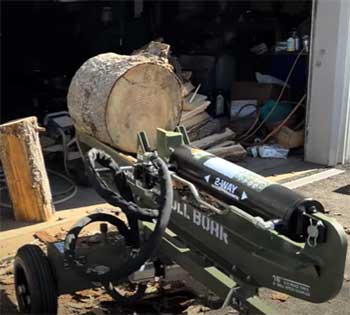
The Full Boar 27-Ton, often sold at Tractor Supply for around $1,199, is a solid contender with a 208cc engine and a 14-second cycle time, matching the Crimson Force’s speed.
I borrowed one from a friend last season, and it powered through knotty oak rounds without hesitation, much like my Crimson Force.
However, the Full Boar’s log cradle is sturdier, with thicker steel that holds smaller logs better—something I wish Crimson Force had.
On the flip side, Full Boar’s tires are smaller (14-inch vs. Crimson’s 16-inch), making it less stable on rough terrain like my gravel driveway.
The Crimson Force also feels more robust overall, with its I-beam frame showing no flex under pressure, while the Full Boar’s frame wobbled slightly with larger logs. Price-wise, Crimson Force saves you about $100, making it a better value for similar performance.
- Crimson Force Vs. Champion 27-Ton Log Splitter
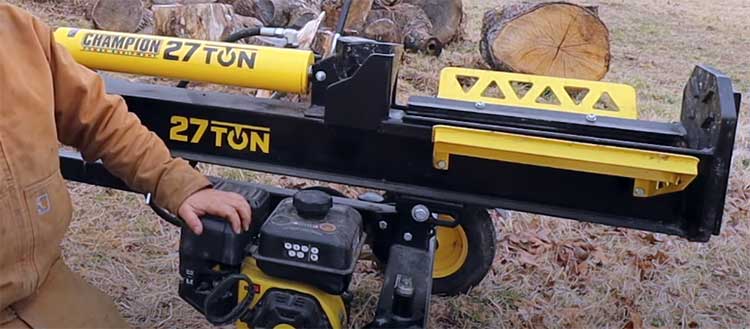
The Champion 27-Ton, priced at $1,349 at Home Depot, brings a bit more polish with its 224cc engine and a faster 11-second cycle time. I used one at a neighbor’s, and the speed was noticeable—great for high-volume splitting.
It chewed through green maple like my Crimson Force, but its fenders bent when I accidentally dropped a log, unlike the Crimson’s tougher build. Champion’s customer service is a standout; they replaced a faulty valve for my neighbor quickly.
However, the Crimson Force’s convertible horizontal/vertical design is just as versatile, and its lower price ($1,099) makes it more budget-friendly. If speed is your top priority, Champion edges out, but Crimson Force wins for cost-conscious buyers like me.
- Crimson Force Vs. LumberJack 27-Ton Log Splitter

The LumberJack 27-Ton, retailing for about $1,249 online, is another strong option with a 212cc engine and a 13-second cycle time. I checked one out at a local dealer, and its compact design is great for smaller yards—slightly easier to store than the Crimson Force.
It split my test pile of hickory cleanly, but the wedge seemed less durable, showing minor nicks after just a few rounds. Crimson Force’s 9-inch hardened steel wedge held up better over time. LumberJack’s warranty is clearer (two years vs.
Crimson’s vague one-year), but its log catcher is an optional add-on, while Crimson Force includes it standard. For my needs, Crimson Force’s lower cost and included features make it the better pick for most homeowners.
Frequently Asked Questions (FAQ)
Crimson Force log splitters are sold by retailers like Rural King, but the manufacturer is YTL International, a company known for producing outdoor power equipment. While YTL is based in the USA, some components may be sourced globally, so it’s not entirely clear if the splitters are fully made in the USA. Contact YTL or Rural King for precise manufacturing details.
“Best” depends on your needs, but Iron and Oak and Timberwolf are often praised for commercial-grade quality, with robust builds and features like log lifts. For homeowners, Crimson Force, Champion, and Troy-Bilt offer excellent quality for the price. My Crimson Force has been reliable for heavy residential use, but Iron and Oak edges out for pro-level durability.
Warranty details are murky, but Crimson Force typically offers a one-year limited warranty on parts and labor. Check with the retailer (like Rural King) at purchase, as terms can vary. Compared to Champion’s clear two-year warranty, this lack of transparency is a drawback, so confirm before buying.
Yes, several brands produce log splitters in the USA. Iron and Oak, Timberwolf, and some Ariens models are manufactured domestically, often with American components like Honda or Kohler engines. Crimson Force splitters, while sold by a US company, may include imported parts, so verify with the manufacturer if USA-made is a priority.
Why the Crimson Force Log Splitter Is Worth Your Money?
You’re not just buying a tool with the Crimson Force Log Splitter—you’re buying time, energy, and peace of mind. This machine’s power, versatility, and affordability make it a no-brainer for anyone who splits wood regularly.
Whether you’re heating your home or prepping for epic bonfires, it turns a grueling task into a quick job. I’ve split cords of wood without breaking a sweat, and you can too.
Grab one, and you’ll be stacking firewood with a smile instead of a sore back.
